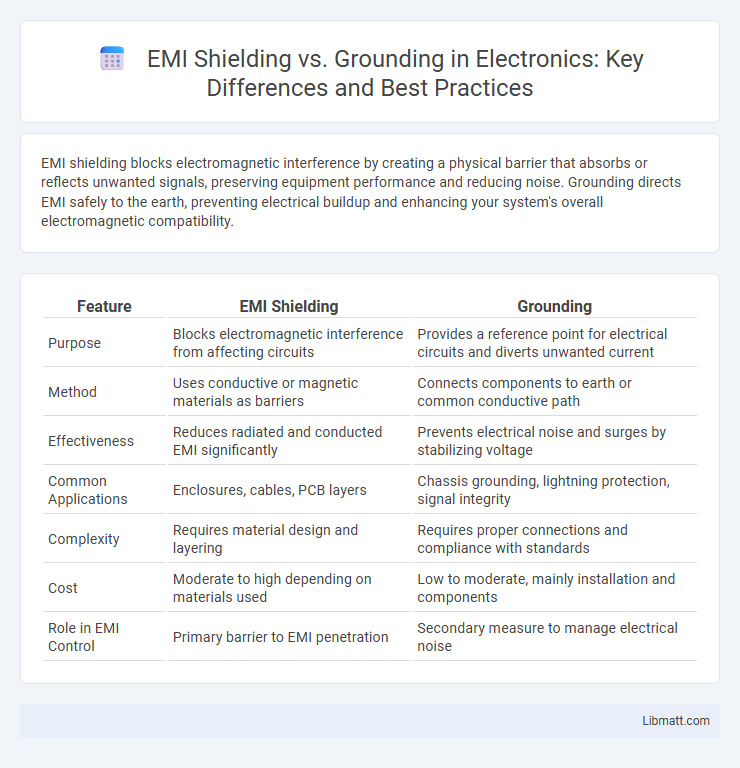EMI shielding blocks electromagnetic interference by creating a physical barrier that absorbs or reflects unwanted signals, preserving equipment performance and reducing noise. Grounding directs EMI safely to the earth, preventing electrical buildup and enhancing your system's overall electromagnetic compatibility.
Table of Comparison
| Feature | EMI Shielding | Grounding |
|---|---|---|
| Purpose | Blocks electromagnetic interference from affecting circuits | Provides a reference point for electrical circuits and diverts unwanted current |
| Method | Uses conductive or magnetic materials as barriers | Connects components to earth or common conductive path |
| Effectiveness | Reduces radiated and conducted EMI significantly | Prevents electrical noise and surges by stabilizing voltage |
| Common Applications | Enclosures, cables, PCB layers | Chassis grounding, lightning protection, signal integrity |
| Complexity | Requires material design and layering | Requires proper connections and compliance with standards |
| Cost | Moderate to high depending on materials used | Low to moderate, mainly installation and components |
| Role in EMI Control | Primary barrier to EMI penetration | Secondary measure to manage electrical noise |
Introduction to EMI Shielding and Grounding
EMI shielding involves the use of conductive or magnetic materials to block electromagnetic interference from affecting electronic devices, ensuring signal integrity and device performance. Grounding provides a low-resistance path for electrical currents to dissipate unwanted electromagnetic energy safely into the earth, preventing interference buildup. Both EMI shielding and grounding are critical for minimizing electromagnetic interference in sensitive electronic systems and improving overall electromagnetic compatibility (EMC).
Understanding Electromagnetic Interference (EMI)
Electromagnetic Interference (EMI) disrupts electronic signals, causing noise and performance degradation in sensitive equipment. EMI shielding involves using conductive or magnetic materials to block or attenuate unwanted electromagnetic waves, preventing interference in your devices. Grounding provides a reference point for electrical circuits and dissipates excess EMI energy safely into the earth, minimizing signal distortion and enhancing device reliability.
What is EMI Shielding?
EMI shielding involves the use of conductive or magnetic materials to block electromagnetic interference from affecting electronic devices, improving signal integrity and performance. It works by reflecting or absorbing stray electromagnetic waves, preventing them from disrupting your equipment. Unlike grounding, which directs unwanted noise to the earth, EMI shielding creates a physical barrier to control interference at the source.
What is Electrical Grounding?
Electrical grounding is the process of creating a direct physical connection between an electrical system and the earth, ensuring safety by preventing electrical shock and equipment damage. It stabilizes voltage levels and provides a path for fault currents, minimizing the risk of electrical hazards. Understanding grounding helps you distinguish its role from EMI shielding, which primarily protects against electromagnetic interference rather than electrical faults.
Key Differences Between EMI Shielding and Grounding
EMI shielding uses conductive or magnetic materials to block electromagnetic interference by creating a physical barrier, while grounding directs unwanted electrical noise safely into the earth to prevent interference. Shielding primarily controls radiated emissions, whereas grounding manages conducted emissions and system stability. Your choice between EMI shielding and grounding depends on the specific type of interference and the design requirements of your electronic system.
Applications of EMI Shielding
EMI shielding is essential in applications such as aerospace, telecommunications, medical devices, and consumer electronics to prevent electromagnetic interference that can disrupt sensitive electronic components. Shielding materials like copper, aluminum, and conductive polymers create barriers that block or attenuate electromagnetic waves, ensuring device reliability and compliance with regulatory standards. Unlike grounding, which provides a path for excess current, EMI shielding directly addresses radiated and conducted interference by isolating signals within electronic enclosures.
Applications of Grounding in Electronics
Grounding in electronics is essential for preventing electrical shock, stabilizing voltage levels, and ensuring proper operation of electronic circuits by providing a reference point for signal integrity. It is widely used in applications such as power supplies, circuit boards, and communication systems to reduce noise and interference. Effective grounding complements EMI shielding by directing unwanted electromagnetic energy safely to the earth, enhancing overall electromagnetic compatibility (EMC).
Advantages and Limitations of EMI Shielding
EMI shielding provides effective protection against electromagnetic interference by encapsulating sensitive electronics, reducing signal disruption and enhancing device performance. Its advantages include preventing noise infiltration and maintaining data integrity, but limitations arise from increased design complexity, added weight, and potential cost escalation. You must balance shielding benefits against these constraints when optimizing your system's electromagnetic compatibility.
Advantages and Limitations of Grounding
Grounding offers the advantage of creating a physical reference point to dissipate unwanted electromagnetic interference (EMI), enhancing system stability and safety by preventing electric shock hazards. However, its limitations include susceptibility to ground loops, which can introduce additional noise, and ineffectiveness against high-frequency EMI without complementary shielding techniques. Your electronic design benefits from combining grounding with proper EMI shielding to achieve optimal interference mitigation.
Choosing the Right Approach: EMI Shielding vs Grounding
Choosing the right approach between EMI shielding and grounding depends on your specific electromagnetic interference challenges and system requirements. EMI shielding uses conductive or magnetic materials to block or attenuate electromagnetic waves, effectively protecting sensitive components from external noise. Grounding provides a low-impedance path to dissipate unwanted electrical energy, reducing interference by stabilizing voltage levels and minimizing noise, making it essential in circuit design and equipment safety.
EMI Shielding vs Grounding Infographic

 libmatt.com
libmatt.com